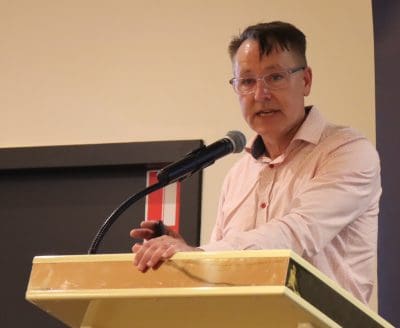If climate change has been progressing and getting worse, it is not because of the Australian red meat industry.
 “That is the bottom line” of analysis looking at pathways to climate neutrality by 2030 conducted by CSIRO Principal Research Scientist Brad Ridoutt (right), and presented at the Cattle Australia industry forum in Albury last Friday.
“That is the bottom line” of analysis looking at pathways to climate neutrality by 2030 conducted by CSIRO Principal Research Scientist Brad Ridoutt (right), and presented at the Cattle Australia industry forum in Albury last Friday.
While Dr Ridoutt acknowledged the conclusion “may appear shocking” to some, he said “that is the reality, because your balance sheet has not been increasing.”
“With the radiative forcing footprint, your industry has more or less plateaued since around 2015.
“So that is the bottom line story here, and if interventions (such as feeding methane reducing feed supplements) are successful, they lead to a negative (warming) scenario”.
Throughout his presentation Dr Ridoutt regularly quoted research and reports from the United Nations Food and Agriculture Organisation (FAO) and Inter-governmental Panel on Climate Change (IPCC), explaining: “I want you to know it is not just me saying something, this is in the words of these authoritative organisations.”
Some scientists, basing their conclusions on the metric known as Global Warming Potential 100 (GWP100), describe every emission of methane as bad, regardless of whether it originated from a fossil fuel or from a biogenic source such as livestock.
They have warned against industry debating which metric is the most appropriate for measuring the warming influence of methane emissions from livestock, saying the Paris Agreement has “explicitly adopted” the GWP100 metric as a way of converting methane into carbon dioxide equivalence, and say IPCC reports show the livestock sector will have to reduce emissions by 60 percent to achieve the Paris Agreement Goal (of limiting global temperature increases to 2pc of pre-industrial levels).
Yet the same IPCC science has led other scientists, who are independent with no vested interests in the livestock sector, to arrive at very different conclusions.
Among them is Dr Ridoutt, who explained last Friday that the choice of climate metrics in fact “makes a world of difference for beef”, because the industry’s emissions are mainly methane.
The reality is that there is “no absolute equivalence” between CO2 and methane and other greenhouse gases, he said: “all have unique characteristics, all last for different lengths of time in the atmosphere and all have different greenhouse effects”.
“The most appropriate metric depends on the policy objective”
A recently published UN FAO report on methane emissions in agriculture states that “the most appropriate metric depends on the policy objective”, Dr Ridoutt said.
He also pointed out that the central aim of the Paris Agreement is to keep global temperature rises this century to below 2 degrees Celsius above pre-industrial levels, with a further aim of limiting rises to no more than 1.5 degrees Celsius above pre-industrial levels.
 “So all of this talk about greenhouse gas emissions and mitigation, it is all aimed towards a goal of stabilising the climate.”
“So all of this talk about greenhouse gas emissions and mitigation, it is all aimed towards a goal of stabilising the climate.”
He said the IPCC makes clear distinctions between CO2, which has a very long term impact (potentially thousands of years in the atmosphere), and gases such as methane which have a very short term impact (10-12 years).
“Methane comes and goes from the atmosphere very quickly, and a more or less steady rate of emission of methane is consistent with climate stabilisation, because new emissions are simply replacing emissions that are disappearing from the atmosphere, so it is a natural cycle so to speak,” he said.
GWP100 initially adopted for ‘political convenience’
He said GWP100 was initially adopted in the 1990s for “political convenience” to help add up emissions for use in the Kyoto Protocol.
“In that protocol it was decided to have a multi-gas protocol. Policy makers needed a way of adding up the different emissions and the scientists at the time said, ‘well, there is no obvious way of adding up these emissions, you add them up in different ways you get all sorts of different answers’.
“And yet, to have a multi-gas protocol they needed something, and for political convenience this GWP 100 metric was adopted.
“It is probably the one you are most familiar with.
“But I want to point out the fact that it actually says there in the text there is no scientific argument for selecting this way of adding up the emissions, as opposed to other ways of adding up the emissions.”
IPCC language now differentiates between Carbon Neutral and Greenhouse Gas Neutral
He said the IPCC’s language has shifted over the years.
Its latest assessment report now uses the phrase “Carbon Neutral” specifically only in relation to CO2, while using the terminology “Greenhouse Gas Neutrality” when talking about other greenhouse gases.
The objective of a “Carbon Neutral” goal is a target to achieve no more emissions, he said.
The objective of a “Climate Neutral” goal was no more warming.
“Is the (red meat industry’s) objective no more warming? Or is it no more emissions?
“Because the current industry target is no more emissions. CN30 is about no more emissions.
“And that is where we come to this increasingly used terminology which relates to climate neutrality.
“It is not about no more emissions, it is about no more incremental contribution to climate change.”
He said there are three main metrics currently being talked about – GWP100, GWP* (GWP star) and radiative forcing footprint – and all are based on exactly the same IPCC science.
The ‘right’ metric comes down to the objective being pursued
He said there is no metric that is right or wrong. The question of which metric is the most appropriate relates to the policy or objective being pursued.
“The reality is that with GWP100, it does paint your industry as a very heavy polluting greenhouse gas polluting industry.
“On the other hand, other metrics show that the industry has not been making any contribution to climate change since around 2015 for almost a decade.
“So the first thing you can take away from that is the fact that it is the same emissions, you are just adding them up differently, the conclusion is entirely based on the choice of the model.
“And I would argue the GWP* or the radiative forcing footprint are much more relevant if the goal is to stabilise the climate.”
He said that while metrics matter little when the primary gas emitted is CO2, metrics made a huge difference when your primary emission is methane.
“Yours is a special case. It is mainly methane, and what’s more it is biogenic methane.
“It is not fossil methane that is adding new CO2 to the atmosphere.
“It is CO2 that was taken up in grass, that eventually goes back through methane to CO2 in the atmosphere.”
He said in his view the GWP star or the radiative forcing footprint were much more relevant metrics to use “if the goal is to stabilise the climate”.
“The industry is not making any contribution to climate change since about 2015, so if climate change has been progressing and getting worse, it is not because of your industry, that is the bottom line.”
